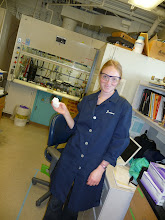
(Image taken from Creative Commons)
Did you ever wonder how Professor Johnston and his team were able to travel back to the Middle Ages in Michael Crichton's novel Timeline? Or what the "Tunnel" in Carpal Tunnel Syndrome is all about?
Well, I can't answer the latter question, but there is actually a very simple explanation for the former phenomenon: quantum mechanical tunneling!
In order to gain a basic understanding of tunneling, we should first review the so-called "wave-particle duality." In quantum mechanics, wavefunctions (solutions to the Schrodinger equation) are used to describe ANY physical system under consideration. The wavefunction's values are probability amplitudes, which can be used to determine the likelihood that the system of interest will be in a certain state at a certain time. We can make measurements on the wavefunction to determine information about the system.
For example, we can determine the frequency of a vibrating system (such as a bond between two atoms, or a guitar string). We can also determine the position of a moving particle. And if we wish to measure the frequency for this same moving particle, we will access a wave. The particle can at once be treated as a wave and as a particle. And if you are confused, ok! Most people are.
But don't let that stop us from trying to rationalize the possibility that a molecule (or "system" for that matter) without enough energy to traverse a barrier could actually just cut through the barrier to get to the other side. The "particle" wave has a finite probability of traversing the barrier.
If you recall from the entry on the Arrhenius equation, we examined the relationship between the rate constant, the temperature and the activation barrier. A modified version of the Arrhenius equation, which includes a "tunneling correction factor," Q, is used to analyze tunneling. Q depends exponentially on the mass of the tunneling system, and tunneling is more common for a light particle (e.g., a hydrogen atom or an electron). For this reason, kinetic isotope effects may be used to analyze tunneling events: substitution of a hydrogen by deuterium will lead to a dramatic decrease in the rate of a tunneling process.
An example of tunneling in an organic reaction was shown in the case of olefin generation via selenoxide elimination. In this case, a large kinetic isotope effect was observed and an unusually large difference in the A values for the D- and H- reactions was found (collisional theory would predict a 1:1 ratio of AD to AH).
At this point you might be wondering why people never tunnel through chairs when they sit down. To put it simply, our wavelengths are just too short!





5 comments:
congrats on the new blog. looks cool.
pretty much all greek to me :P
how have you been?
have you been visiting my blog? :)
hope you are doing well
you never replied my last text msg eons ago....:(
Oh. My. Goodness. I haven't heard from you in ages! And the funny thing is that I thought about you today. Sorry about not responding to your last text... I'm not quite sure what happened! I'll call you soon so we can catch up.
Thanks for checking out the blog :-).
I'm going to check out yours right away.
why don't we tunnel through chairs i don't get it?
Wavelength is inversely proportional to the momentum of the particle/system, and momentum is equal to the product of mass and velocity. So as mass increases, wavelength decreases. Whereas hydrogen atoms and electrons have measurably small wavelengths, humans do not, so tunneling through objects is an impossibility for us.
Great blog! Well written. Thanks!
Post a Comment